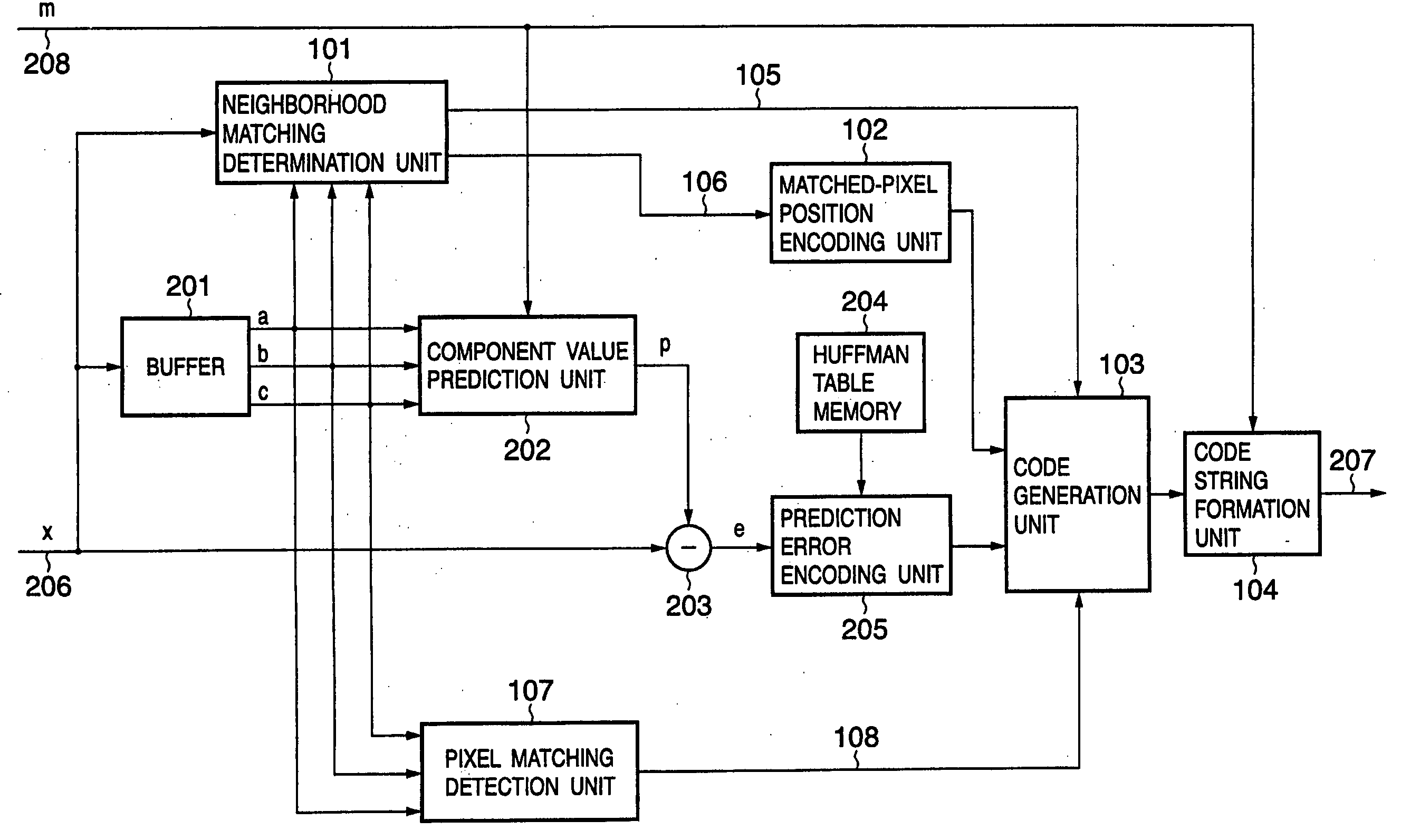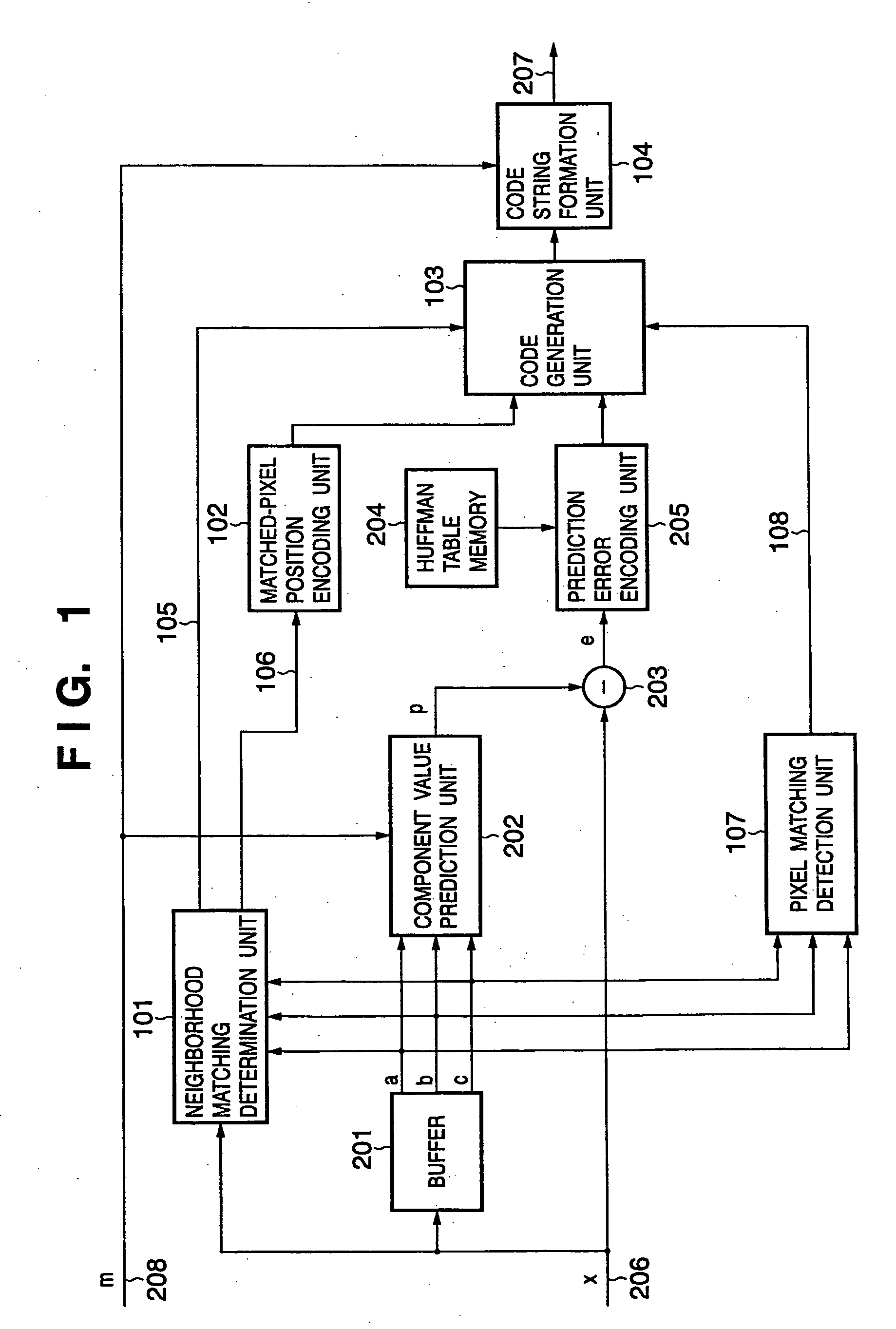Image encoding apparatus, image decoding apparatus, control method therefor, computer program, and computer-readable storage medium
a technology of image encoding and decoding apparatus, applied in the direction of electrical apparatus, instruments, computing, etc., can solve the problem of low compression ratio, and achieve the effect of efficient encoding a natural image and relatively limited number of appearance colors
- Summary
- Abstract
- Description
- Claims
- Application Information
AI Technical Summary
Benefits of technology
Problems solved by technology
Method used
Image
Examples
first embodiment
[0068]FIG. 1 is a block diagram showing an image processing apparatus according to the first embodiment.
[0069] As shown in FIG. 1, the image processing apparatus according to the first embodiment comprises a neighborhood matching determination unit 101, matched-pixel position encoding unit 102, code generation unit 103, code string formation unit 104, buffer 201, component value prediction unit 202, and subtracter 203. The apparatus also comprises a Huffman table memory 204, prediction error encoding unit 205, and pixel matching detection unit 107. In FIG. 1, reference numerals 206, 207, 208, 105, 106, and 108 denote signal lines. The same reference numerals denote blocks which perform the same operations as those of processing blocks in the conventional image processing apparatus described in BACKGROUND OF THE INVENTION with reference to FIG. 2, and a description thereof will be omitted.
[0070] An image encoding process performed by the image processing apparatus according to the ...
modification to first embodiment
[0104] The first embodiment may be implemented by software. The modification will explain a case wherein the first embodiment is implemented by software.
[0105] When the first embodiment is implemented by software, processes corresponding to various building components typified by the neighborhood matching determination unit 101 shown in FIG. 1 are implemented by functions, subroutines, and the like in software. In the modification, the names of the processing units in FIG. 11 are directly used for descriptive convenience. A buffer 1201 and code buffer 1101 are allocated in a RAM 1402 by a CPU 1401 prior to the start of a process.
[0106]FIG. 14 is a block diagram showing the basic configuration of the apparatus when the apparatus is implemented by software.
[0107] In FIG. 14, the CPU 1401 controls the overall apparatus by using programs and data which are stored in the RAM 1402 and a ROM 1403. In addition, the CPU 1401 executes image encoding and decoding processes to be described l...
second embodiment
[0124] An example of decoding encoded data which is generated in the first embodiment (or its modification) will be described as the second embodiment. The decoding process is basically executed by procedures opposite to those of the encoding process in the image processing apparatus according to the first embodiment.
[0125]FIG. 11 is a block diagram showing an image processing apparatus which decodes encoded image data according to the second embodiment.
[0126] As shown in FIG. 11, the image processing apparatus according to the second embodiment comprises a code buffer 1101, header analysis unit 1102, matched-pixel position decoding unit 1103, prediction error decoding unit 1104, selector 1105, switch 1106, and buffer 1201. The apparatus also comprises a component value prediction unit 1202, adder 1111, and pixel matching detection unit 1150. In FIG. 11, reference numerals 1113, 1108, 1109, 1110, and 1112 denote signal lines.
[0127] A process performed by the image processing appa...
PUM
 Login to View More
Login to View More Abstract
Description
Claims
Application Information
 Login to View More
Login to View More - R&D
- Intellectual Property
- Life Sciences
- Materials
- Tech Scout
- Unparalleled Data Quality
- Higher Quality Content
- 60% Fewer Hallucinations
Browse by: Latest US Patents, China's latest patents, Technical Efficacy Thesaurus, Application Domain, Technology Topic, Popular Technical Reports.
© 2025 PatSnap. All rights reserved.Legal|Privacy policy|Modern Slavery Act Transparency Statement|Sitemap|About US| Contact US: help@patsnap.com



